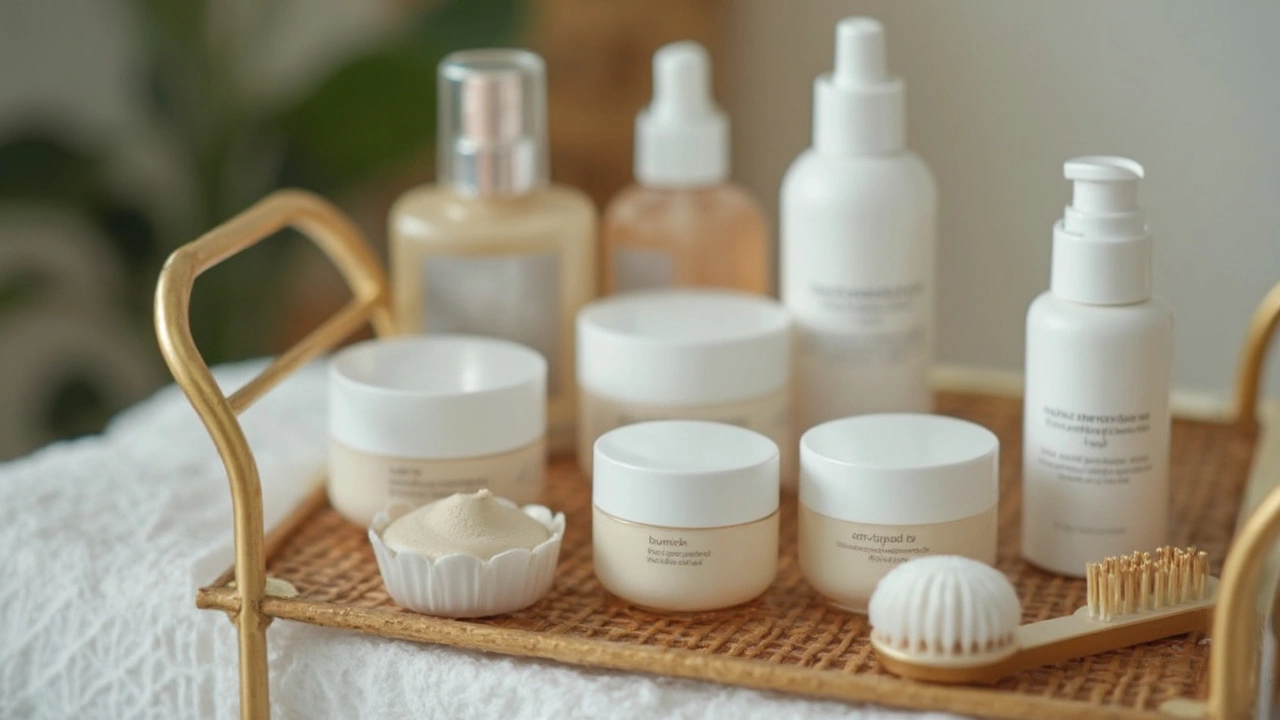
You see it everywhere—'professional skin care' slapped across spa menus and product ads. But what does it actually mean? It’s more than fancy creams and spa music. 'Professional skin care' is what estheticians and dermatologists call the use of special products and advanced treatments that you can’t just pick up at any store or copy at home.
Some treatments dive deep, like dermaplaning, chemical peels, or microneedling. These aren’t your everyday face masks—they’re done by trained hands, with safety and real results in mind. The term professionals use is usually 'clinical skin care' or 'medical-grade skincare.' If you’ve ever wondered what makes an in-clinic facial different from your sheet mask binge at home, you’re in the right spot. We’ll break down the key ideas, bust some myths, and give you tips so you can walk into your next appointment actually knowing what you’re talking about.
- Breaking Down the Basics: What Professional Skin Care Means
- Meet the Experts: Who Does Professional Skin Care?
- Popular Professional Skin Care Treatments
- Professional vs. Over-the-Counter Products
- Tips for Choosing the Right Treatment
Breaking Down the Basics: What Professional Skin Care Means
When people talk about professional skin care, they're talking about more than just fancy lotions. Professional skin care means using products, tools, and techniques that you usually can’t get at a drugstore or do safely at home. The focus isn’t only on a quick glow—it’s about skin health, targeted results, and long-term changes.
This world includes both in-clinic treatments and special products made for use by certified professionals. These items and services are often backed by research and are tested for things like how well they work and how safe they are. Because of strict rules, they’re typically only available through trained experts.
Check out this quick table to see the main differences:
| Aspect | Professional Skin Care | At-Home Skin Care |
|---|---|---|
| Who Can Use | Licensed expert | Anyone |
| Product Strength | High/Medical-grade | Mild/Over-the-counter |
| Custom Care | Yes—skin is analyzed first | No—one-size-fits-all |
| Results | Targeted, long-lasting | Usually more basic |
| Risk of Side Effects | Managed by pro | Higher if used incorrectly |
The real win with professional treatments? You get a skin analysis, so your skincare isn’t guesswork. You’ll likely hear words like “clinical” or “medical-grade,” which mean stronger formulas that get deeper and work quicker than your average face wash. Dermatologists or estheticians can tweak treatments for acne, signs of aging, or even stubborn sun spots.
If you’re curious about effectiveness, clinical skin care trials and real-world results show that professional products and treatments can make a visible difference, especially for issues like acne or uneven skin tone. That’s why so many people book regular visits with a pro instead of just hopping between new store-bought trendy products.
Meet the Experts: Who Does Professional Skin Care?
It’s easy to get lost in who actually gets to call themselves a pro in skin care. Not every white coat means the same—let’s clear up the people you’ll meet when you go beyond DIY creams.
There are two main types of experts in professional skin care: estheticians and dermatologists. Both work with skin, but there’s a big difference in training and what they can actually do for you.
- Estheticians: These are licensed skincare specialists you’ll find in spas and skin clinics. Their training covers skin analysis, facials, exfoliation, waxing, and understanding product ingredients. They’re the ones doing your deep-cleansing facials, LED light treatments, and microdermabrasion. In most US states, becoming a licensed esthetician takes around 600 hours of schooling, plus a state exam.
- Dermatologists: These are actual medical doctors—think acne, rashes, skin diseases. Dermatologists do all the things estheticians can do, plus prescribe medications and perform medical procedures like chemical peels, fillers, and laser treatments. They go through years of medical school and residency. If your skin concern is serious or you’re thinking about procedures like Botox or mole removal, a dermatologist is your go-to.
There’s also a new wave: nurse practitioners and physician assistants in dermatology clinics. They’re medical professionals too, and they can treat skin problems, prescribe meds, and even perform some procedures under doctor supervision.
If you walk into a med spa, you might meet both estheticians and nurses. Always check credentials, especially if someone’s offering injections or lasers—those require advanced medical training.
Knowing who does what can save you money, time, and a lot of stress. If you just want glowing skin, facials, or gentle advice, an esthetician’s your person. If you need help with acne that won’t quit or want to try out advanced treatments, find a board-certified dermatologist.

Popular Professional Skin Care Treatments
Let’s talk about what actually happens in a professional setting besides gentle cleansers and relaxing music. Here are some of the most common professional skin care treatments you’ll see at clinics, med spas, or dermatologist offices—and why people line up for them.
- Chemical Peels: This isn’t nearly as scary as it sounds. A pro applies a blend of acids to help peel away dead skin layers, revealing smoother, brighter skin. Different peel strengths target different issues, like breakouts or stubborn dark spots. There’s a reason this is one of the most-requested office treatments.
- Microdermabrasion: Think of this as superpowered exfoliation. A specialized device gently buffs the skin, helping with texture and uneven tone. It’s safe for most skin types and won’t keep you hiding at home during recovery.
- Microneedling: This treatment involves tiny needles making micro-punctures in the skin to kickstart collagen production. It’s big for reducing scars, fine lines, and even big pores. No, it doesn’t hurt as much as it sounds, especially with numbing cream.
- Hydrafacial: This feels more like a spa treat. It combines cleansing, exfoliating, extracting, and hydrating—all in one go. It’s gentle but makes skin seriously glowy in under an hour. People rave that it delivers instant results.
- LED Light Therapy: Not just a sci-fi prop, these LED masks or panels zap acne bacteria and calm inflammation with specific light wavelengths. Totally non-invasive and now hugely popular because there’s zero downtime.
- Laser Treatments: Used for everything from acne scars to sunspots and even unwanted hair, lasers come in all types and strengths. These are definitely not DIY—find someone who really knows their stuff.
Curious how popular these treatments are? Here’s a quick look at some U.S. numbers for 2024:
| Treatment | # Procedures Performed (2024) | Average Cost per Session (USD) |
|---|---|---|
| Chemical Peel | 1,400,000+ | 250 |
| Microdermabrasion | 650,000 | 150 |
| Hydrafacial | 850,000 | 200 |
| Laser Treatments | 2,000,000+ | 400 |
A key takeaway: these treatments are not one-size-fits-all. Your skin goals, type, and even your schedule play into what works best. If you’re serious about seeing big changes, go for a professional consult and ask what fits your vibe and budget. Also, don’t let fancy names alone wow you—ask for before-and-after photos and honest answers about side effects, downtime, and aftercare.
Professional vs. Over-the-Counter Products
Everyone’s tempted by those pretty bottles lining drugstore shelves, but there’s a world of difference between what you grab at the pharmacy and what pros use in clinics. Here’s the thing: over-the-counter (OTC) skin care is designed to be safe for pretty much anyone, even the friend who still forgets to wear sunscreen. That means lower ingredient strength and fewer active ingredients per bottle.
Professional skin care—sometimes called clinical, medical-grade, or cosmeceutical—levels up fast. These products pack higher concentrations of stuff that actually changes your skin, like retinoids, peptides, and growth factors. Many need a prescription or are sold only by licensed pros because they’re meant to be used with expert guidance.
- OTC products: Safe, basic, but often slow or mild when it comes to noticeable results.
- Professional products: Target real issues—acne, wrinkles, pigment—with more potent blends, but might sting a bit or require an expert to help you avoid mishaps.
For example, an OTC retinol serum will typically contain 0.1% or less active retinol, while a pro-only version might go up to 1%. The jump between those numbers might not sound wild, but in skin care, it’s the difference between getting visible results and barely nudging the needle.
| Product Type | Main Retail Channel | Active Ingredient Strength | Expert Involvement |
|---|---|---|---|
| Over-the-Counter | Drugstores, beauty retailers | Low | Not required |
| Professional | Clinics, spas, dermatologist offices | Medium to High | Usually required |
Another big difference is freshness. OTC products can sit on shelves for a year or more. Professional lines rotate faster, are stored better, and often avoid ingredients that break down easily. Some pro brands also customize formulas for your exact needs—think of it like skin care with a tailor instead of buying off the rack.
If you want something gentle and easy, OTC is a safe start. But if you’re done guessing and want real change, professional products (and the advice that comes with them) are usually the game changer.

Tips for Choosing the Right Treatment
Picking the right professional skin care treatment isn’t just about what’s trendy or Instagram-famous. Your skin type, budget, and even the time you can set aside matter way more than slick marketing. Here are some things to actually put on your checklist before you book anything:
- Start with a consultation: Legit clinics and spas will offer an initial consultation, sometimes free. You’ll talk about your skin goals and concerns. This is when you get to mention allergies, sensitivities, and your skin’s history. If they skip this step, run.
- Ask about credentials: Always make sure your esthetician or dermatologist is licensed. In the U.S., licensing is state-by-state, so check if they’re up-to-date. Never feel awkward asking to see certifications hanging on the wall—it’s your face!
- Understand your skin type: Dry, oily, combo, sensitive—each requires specific ingredients. For instance, folks with acne-prone skin shouldn’t go for heavy oils, while sensitive types should steer clear of harsh peels.
- Know what results to expect: Don’t fall for miracle promises. Ask, 'How many sessions until I see a difference?' Honest pros will give you a straight answer: it varies, and repeat visits are common.
- Research active ingredients: Treatments could include things like retinol, AHAs, or vitamin C. Some ingredients pack a punch and need a pro’s supervision, especially if you’re using prescription meds.
- Check reviews and ask for before-and-afters: Look up the clinic or spa online. People post pictures and stories—good and bad. A decent provider will have proof of past results to show you.
- Consider aftercare: Some treatments mean downtime—redness, flaking, even no sun for days. Make sure their plan fits your lifestyle. Ask what happens if something goes wrong, and get their aftercare tips in writing.
Here’s a quick table with average costs and downtime for popular treatments:
| Treatment | Avg. Cost (USD) | Typical Downtime |
|---|---|---|
| Chemical Peel | $150 - $300 | 1-7 days |
| Microneedling | $200 - $700 | 2-5 days |
| HydraFacial | $150 - $350 | None |
| Laser Resurfacing | $1,000 - $2,500 | 7-14 days |
If a treatment seems too cheap, question it. Real equipment and skilled pros cost money. And remember, the best results come from being honest during your consult and keeping up with recommended product routines at home. Your skin’s worth the extra effort—and asking a few more questions.